Welcome to Tanzania, a land of staggering natural beauty and vibrant cultures.
From the majestic peaks of Mount Kilimanjaro to the endless plains of the Serengeti, home to the awe-inspiring Great Migration, Tanzania promises an unforgettable journey into the heart of the wild. Dive into the crystal-clear waters of Zanzibar, explore the rich heritage of Stone Town, and witness the Big Five in their natural habitat.
Tanzania is not just a destination; it’s an invitation to explore, discover, and be moved by the spirit of Africa.

The Best Time To Visit
The best time to visit Tanzania largely depends on what you want to experience, but there are two peak travel seasons based on the country’s dry periods: from late June to October and from December to March.
Late June to October is the dry season and is considered the best time for wildlife viewing, as animals congregate around water sources, making them easier to spot. This period also coincides with the Great Migration in the Serengeti. The weather is generally cooler and dry, providing comfortable conditions for safaris and outdoor activities.
December to March is another good time to visit, especially for those interested in seeing the Serengeti’s calving season, when many animals give birth, attracting predators and thus offering a unique wildlife experience. This period is warmer and also marks the start of the dry season, making it suitable for climbing Mount Kilimanjaro due to clearer skies and less rain.
What To Know
In Tanzania, the official languages are Swahili and English. Swahili is widely spoken and serves as the national language.
English, while also an official language, is primarily used in higher education, the judicial system, and in international business. It’s less commonly spoken among the general population but is still prevalent in tourism, where it’s used to communicate with visitors.
The currency used in Tanzania is the Tanzanian Shilling. It is the official currency for all transactions within the country, from market purchases to hotel accommodations.
The Shilling is available in various denominations of banknotes and coins, facilitating both large and small transactions. For travelers, it’s advisable to have some local currency on hand for everyday expenses, especially in areas where electronic payments may not be widely accepted.
Credit cards are generally accepted in major hotels, restaurants, and larger stores, particularly in urban and tourist areas, but reliance on cash transactions remains high across much of Tanzania.
Tanzania is generally considered a safe destination for travelers, especially in tourist areas and national parks. The country is known for its friendly people and rich cultural heritage, and many visitors enjoy their stay without any significant safety issues. However, like any travel destination, it’s important to exercise caution and be aware of potential safety concerns.
In urban areas, such as Dar es Salaam and Arusha, and in tourist spots, petty crimes like pickpocketing, purse snatching, and opportunistic theft can occur. Travelers are advised to be vigilant, especially in crowded places, and to avoid carrying large sums of money or displaying expensive items. It’s also wise to use reputable taxi services or arrange transportation through your accommodation, particularly at night.
Health-wise, visitors should take precautions against malaria and other tropical diseases, follow advice on food and water safety, and consider health and travel insurance for their trip.
Public transport in Tanzania is predominantly served by minibuses known as “dala-dalas” for urban and intercity travel, and by larger coaches for longer distances between cities. Dala-dalas are a common sight in cities like Dar es Salaam and Arusha, offering an affordable way to navigate the urban sprawl, though they are often crowded and operate without a fixed schedule.
For travel between cities and to more remote areas, larger bus companies operate services that range from basic to more luxurious options, with the latter offering reserved seating and air conditioning. These buses are a popular choice for longer journeys, connecting major towns and tourist destinations across the country.
In addition to road transport, Tanzania also has a railway network that provides passenger services between major cities and to neighboring countries, though services can be infrequent and slower compared to road transport.
Taxis and motorcycle taxis (boda-bodas) are available in urban areas for short distances or where public transport is less accessible. Negotiating the fare in advance is customary.
While public transport in Tanzania can be an adventure in itself and a window into local life, it might not always meet the comfort and safety standards international travelers are accustomed to. Renting a car with a driver or using reputable tour operators can provide a more reliable and comfortable way to explore the country’s attractions.
Tanzania Travel Guides
April 24, 2022
